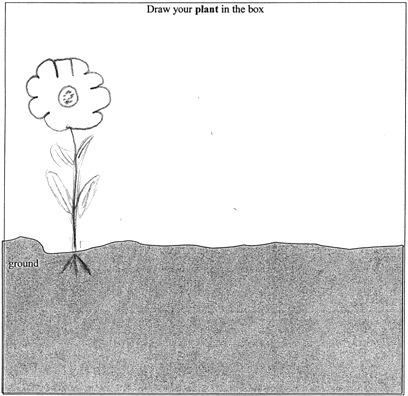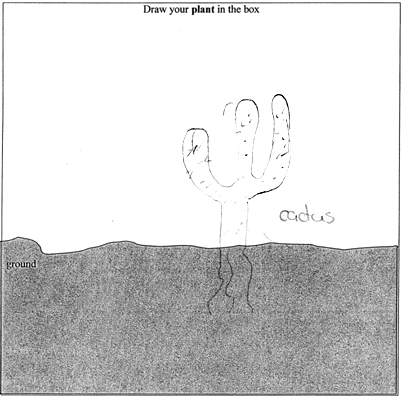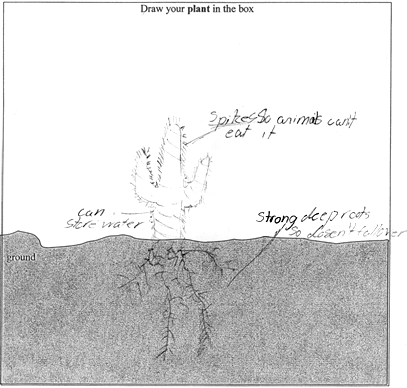Design a plant
Here are some notes on a plant:
- It lives in hot dry places.
- Strong winds sometimes blow in this area.
- Animals like to eat it if they can.
- It needs birds to take pollen from one flower to another.
- In the box draw a picture of a plant that would look like the one you have just read about and that could survive in these conditions. The ground level has been drawn in for you.
- Label all the special features of the plant and explain how they help it survive.

Drawings should show a plant with features that would ensure its survival:
- in hot dry places (evidence the plant will survive in strong heat, such as reduced leaf size or no leaves or succulent leaves);
- where strong winds blow (shorter plant with a strong root system);
- where animals like to eat it if they can (plant should have some protection against animals, for example, spikes or spiky leaves or an indication of poison);
- where birds can take pollen from one flower to another (plant should have flowers that have something to attract birds, for example, nectar).
| Criteria used | Y6 (10/05) |
|
Draws a plant that is likely to survive in this environment (e.g., cactus) but no explicit identification of specific features.
Identifies and labels at least one specific adaptation of a plant that is likely to survive in this environment. Identifies more than one specific adaptation and explains how the features help the plant survive in this environment. |
moderate
very difficult very difficult |
- In the trial of this resource half the students drew a plant that had a stem, flower, and roots but did not show any specific adaptations to the environment described. Sample1 of the student work samples illustrate this. Pictures such as these were counted as an incorrect response.
- Only 4% of students in the trial explained how the specific features of the plant helped it survive in the environment described. If students don't label their diagram ask for oral explanations.
Student work samples
Sample 1
This student drew a plant but did not show any specific adaptation.

Sample 2
This student has drawn a plant that is likely to survive in this environment, but not explicitly identified specific features.

Sample 3
This student has identified and labelled one specific feature.

Sample 4
This student has identified more than one specific feature and explained how the features help the plants survive.

Misconception
A few students (13) interpreted the statement that 'animals like to eat it' as meaning they should design a plant that was easy for animals to eat rather than a plant with protection from animals.
Very few students explained how the specific features of the plant helped it survive. As a first step check that students appreciate the general functions of the main parts of plants before moving on to explore how these main parts can be adapted to help plants survive in particular environments.
The following Level 3 ARB items can be used to support and scaffold students in their understanding of different types of plants and their structure.
On the Move
Plants and where they grow
Leaves for extreme climates
School Journal, Part 1, No 5, Learning Media, 2003. Seeds that wear life jackets. This story describes how mangrove plants have particular features to suit their environment.
Ministry of Education (2002). Building Science Concepts Book 26, Making New Plants. Wellington: Learning Media.
Ministry of Education (2003). Building Science Concepts Book 35, Is this a Plant? Wellington: Learning Media.
Ministry of Education (1999). Making better sense of the Living World. Wellington: Learning Media. The following activities are relevant:
- Focusing on Flowers, Activity 3, p85
- All about pollination, Activity 4, p86
- Threatened or Endangered? Investigation 3, p92
Biology of Plants website www.mbgnet.net/bioplants/adapt.html
This website gives lots of information about ways plants are adapted to live in different climates. It also includes a game about adaptations.

